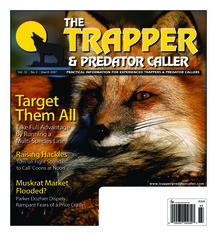Fur Market Report: March 2007
By Parker Dozhier

GENERAL OUTLOOK
Without rumors, the fur trade would be dull. Most rumors have no known beginning or end. They simply come to us out of the ether. And most are discounted immediately.
But I’m learning it is always wise to pay attention — like the rumor that reached my desk a year ago regarding otters.
A fur buyer who called, and wishes to remain anonymous, simply asked: “Have you heard anything about otter prices tanking?”
I told him I hadn’t, and the rumor seemed to become even more far-fetched when he offered his response.
“Well,” he said, “I heard that some of the Chinese who bought pale otter on the February auctions are moving around out in the country trying to sell the skins to some of the larger collectors.”
Since the fur buyer is a reliable and trusted friend, I certainly was not in a position to offend him. Still, the idea seemed ridiculous.
Well, we know how that rumor played out. And I’ve vowed to dig a bit deeper into rumors in the future.
Now, rumor has it that muskrat prices have plummeted. One version of the rumor claims Hong Kong fur merchants will no longer pay the high prices. Another version of the rumor claims we have overproduced and flooded the market. No doubt this line of reasoning was sparked by a North American Fur Auctions press release.
In order to attract as many international buyers as possible, auction houses issue preliminary press releases speculating on the number of skins anticipated to be on each sale. After the last receiving date, when the final numbers are known and the auction catalogue is ready to go to press, the actual size of each offering is publicized.
The preliminary press release missed the estimate by about 100,000 skins. Considering the favorable prices for muskrats last season, it was obvious production would increase. But who could have predicted the weather? Open water for an additional three to four weeks in some highly productive muskrat habitat added a substantial number of skins to the early harvest.
In February, more than 500,000 muskrats will go across the auction block. Virtually all of the skins will be taken by Chinese fur traders. Most of the skins will be headed to North China, not Hong Kong.
Have we flooded the market to such a degree that prices will drop? Will a substantial number of skins remain unsold, dampening the interest in later auctions and resulting in lower prices next season?
In early February, I posed the questions to Bob McQuay, NAFA spokesman.
“While our first major auction of the season is a little over a week from now, we believe the demand for muskrat will track closely with the activity in the ranch mink markets, and those markets remain active,” he said. “The larger the offering the more attractive the sale is to a greater number of buyers.”
This auction season, 42 million ranch mink will come under the gavel. That does not include millions of additional mink produced on farms in China. Considering that sheared muskrat offers an excellent low-cost alternative to sheared mink, our production is merely a drop in the bucket.
About the only impact a large offering could have on price would involve low grades, damaged and small sizes. Last season, the demand was so widespread that even damaged skins and small sizes estimated to be worth a dollar sold for several bucks each. In the early 1980s, the North American harvest of muskrat was roughly 10 million skins annually. The harvest will be less than 2 million this season.
If anything throws the market into a tailspin, it will be the weather. So far, this winter has been exceptionally mild in Western and Eastern Europe. Winter was late in North America, dampening sales of furs and fur-trimmed outerwear.
Addressing the growing importance of China in the fur industry, Copenhagen Fur Center is sponsoring a fashion fur-design studio at a Beijing university. The Academy of Arts and Design at the Tsinghua University hopes to produce innovators in high-fashion designs. One hundred thousand dollars a year in scholarships has been pledged.It is estimated that in less than 10 years, China will be the biggest consumer of luxury goods in the world.
On this side of the Pacific, NAFA has launched Studio NAFA, a state-of-the-art fur-design center that will focus exclusively on wild furs. NAFA’s long-term commitment of nearly a million dollars is expected to result in young avant-garde designers finding new uses for wild fur. We’ll be seeing more of this in the future.
Bid-Rigging Case Update
On Feb. 14, 2004, at the American Legend-Fur Harvesters auction in Seattle, David Karsch of Alaskan Brokerage International, New York Fur Traders, was overheard by auction officials conspiring to rig bids on the otter offering. The information was reported by the auction officials to federal authorities.
An investigation by the FBI lead to a indictment by a Federal Grand Jury for conspiracy to restrain trade.
Karsch pled guilty. But there were several delays in handing down his sentence because of health considerations.
On Jan. 8, 2007, Federal District Judge James Robart sentenced Karsch to four months of confinement in a federal medical/correctional facility. Upon completion of his prison time, Karsch will be subject to be home-confined for an additional four months with electronic monitoring.
The criminal monetary penalties — typically substantial in case of this nature — consisted of an assessment of $100, a fine of $20,000 and no restitution to the damaged parties.
